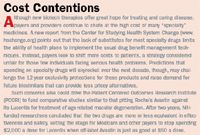Innovation and Collaboration
Pharmaceutical Executive
A rash of "pro-innovative" approaches for testing and regulating medical products offer ways to speed more new products to market.
It seems that most new proposals for improving public health and the nation's economy offer ways to reduce the cost and time of drug development and thus speed more new products to patients. This is particularly evident in the rash of "pro-innovative" approaches for testing and regulating medical products proposed as add-ons to Food and Drug Administration (FDA) user fee legislation moving forward on Capitol Hill.

Jill Wechsler
Typical of the broader look, the "Bioeconomy Blueprint" issued by the White House Office of Science and Technology Policy in April maps out how biotechnological advances can promote economic growth, create new jobs, and improve health. A strong undercurrent in this grab bag of ideas is that innovation will flourish by eliminating unnecessary regulatory roadblocks. Thus it supports revisions in rules governing human subject research and proposes to tap into FDA's vast repository of drug safety and efficacy data to speed drug development.
New drugs from old
The Blueprint also backs public-private partnerships supporting translational research by the National Institutes of Health (NIH) to find new ways to prevent and cure disease. Such an initiative was launched last month by Health and Human Services Secretary Kathleen Sebelius, who joined NIH Director Francis Collins and three pharma companies to announce a pilot that would "rescue" compounds abandoned by industry. Pfizer, AstraZeneca, and Eli Lilly agreed to launch the program by working with researchers on "repurposing" drugs sitting on their shelves.

Cost Contentions
The initiative will start with the new National Center for Advancing Translational Sciences (NCATS) funding $20 million in grants next year to support promising research proposals, along with templates for agreements on dealing with intellectual property. The companies will provide researchers with the compounds and relevant data, while retaining rights to their products. Scientists from academia, non-profits, or biotech companies will be able to publish study results and negotiate licenses on new discoveries. The program intentionally ruled out seeking additional uses for approved drugs, as those raise more complex IP issues. NIH is soliciting comments on the templates, which are key to speeding up negotiations among all parties and making the program work. A list of compounds available for research will be published in a few months, and initial grants awarded next spring.
The manufacturers see the NIH program as a way to extend similar arrangements they already have with individual research institutes, including AstraZeneca's partnership with the United Kingdom's Medical Research Program. The selected compounds have been tested for safety in early clinical trials, but lacked sufficiently robust results to support larger studies. The hope is that these abandoned products will do better with new targets and new indications.
Adding to PDUFA
Legislation to reauthorize the Prescription Drug User Fee Act (PDUFA) and several other new and old FDA user fee programs may also carry a range of proposals for modernizing medical product testing and approval. In addition to the agreed-on PDUFA plan, proposed legislative "enhancements" to the bill aim to make the regulatory process more efficient and predictable. The Senate Health, Education, Labor, and Pensions Committee approved its Food and Drug Safety and Innovation Act (FDASIA) in April, but acknowledged that it still needed to resolve several issues related to innovation and supply chain security before the bill comes up for vote by the full Senate.
Debate continues over incentives for manufacturers to develop new antibiotics and ways to encourage greater FDA use of priority review and fast-track approval strategies to speed new treatments to market. Sponsors would like more flexibility for scientific experts with ties to industry to serve on FDA advisory committees. Both manufacturers and patient advocates want to expand FDA's use of the accelerated approval process, an option that has some agency support.
At the April annual meeting of the Food and Drug Law Institute (FDLI), FDA Commissioner Margaret Hamburg agreed that legislative language could provide "clarity to industry and the public" on the use of accelerated approval for "a wide variety of diseases and conditions, including rare diseases." Hamburg also backed proposals to codify the concept of "breakthrough drugs"—products that elicit such a dramatic response in early clinical trials that they warrant market approval based on limited clinical evidence.
Yet, FDA doesn't want overly proscriptive legislation. Hamburg said nothing about appointing an FDA "chief innovation officer" with authority to ensure that reviewers accept data from unconventional clinical research programs previously okayed by the agency. FDA also opposes industry's proposal to expand its mission statement from "promoting the public health" to include "spurring economic growth." Agency officials say it's impossible to calculate how approval or rejection of a new drug or medical device would affect jobs and growth, as one sponsor might gain from approval, but a competitor could lose.
Ensuring safety
Hamburg expressed concern that the "anti-government and anti-regulation sentiment" expressed in some legislative measures could "lower FDA's high public health standards that have served patients, consumers, industry, and the public health for so long, and so well." High standards for safety and efficacy, she said, "will ensure that innovations actually help patients," and that they receive coverage from third-party payers.
FDA highlighted its increased commitment to drug safety over the last five years in a report from the Center for Drug Evaluation and Research (CDER) on "Advances in FDA's Safety Program for Marketed Drugs." CDER now spends equal resources on post-market oversight as on pre-market approval, reported Director Janet Woodcock, and new authorities have enabled the agency to require more than 385 postmarket drug safety studies, to mandate 65 new safety labeling changes, and to initiate 64 risk evaluation and mitigation strategies since 2008.
However, a report from the Institute of Medicine on "Ethical and Scientific Issues in Studying the Safety of Approved Drugs" calls for the FDA to do more to monitor and disclose safety issues involving marketed medicines. An expert panel, which launched this study in 2010 to help FDA prevent future Vioxx-type safety crises, recommended that FDA create a comprehensive, publicly available document to map drug risks and safety concerns throughout the product lifecycle. CDER officials dismissed that idea, noting that developing such a Benefit and Risk Assessment and Management Plan, or BRAMP, for every approved drug would be "challenging" given the agency's limited resources and probably would require lengthy new rule-making.
Going global
What FDA would like to see in the PDUFA legislation is enhanced authority to ensure the safety and quality of drugs and active ingredients now imported from all over the world, as described in its new report on "Global Engagement" and last year's "Pathway to Global Product Safety and Quality." These documents note FDA's increased overseas presence through its network of international offices, along with its efforts to strengthen regulatory agencies in other countries, to collaborate on science-based standards, to share knowledge and inspection resources, and to develop a range of joint surveillance and preparedness activities.
At the FDLI meeting, Hamburg cited a number of legislative provisions that would enable FDA to deal with rising global drug production: make it easier for FDA to share confidential information with trusted regulatory authorities; enable FDA to refuse admission and to destroy unsafe drug imports; require manufacturers to report to FDA threats to the supply chain; and require a "robust" system to track and trace drugs throughout the supply chain.
The proposed generic drug user fee program, she noted, will support more frequent inspections of foreign manufacturers of active ingredient and drug products. And manufacturers already are reporting earlier to FDA about looming shortage situations. But industry is wary of legislation that sets stiff penalties for a host of reporting and disclosure requirements. And manufacturers don't want to invest millions in a system able to track drugs down to the individual bottle or vial level. The debate continues.
Jill Wechsler is Pharmaceutical Executive's Washington correspondent. She can be reached at jwechsler@advanstar.com

Is Artificial Intelligence a ‘Product’? Products Liability Implications for AI-Based Products
April 10th 2025As the physical products we use evolve to become increasingly complex, traditional products liability frameworks may not always fit to provide remedies for harm that can result from using novel product types.
Navigating Distrust: Pharma in the Age of Social Media
February 18th 2025Ian Baer, Founder and CEO of Sooth, discusses how the growing distrust in social media will impact industry marketing strategies and the relationships between pharmaceutical companies and the patients they aim to serve. He also explains dark social, how to combat misinformation, closing the trust gap, and more.